• The best analysis available: PFF's 2023 QB Annual is the most comprehensive guide to the NFL's most important position. With 13-page profiles for 40 of the league's prominent quarterbacks, you'll get an in-depth look at their strengths, weaknesses and outlooks for the upcoming season.
• Hundreds of data points: Dive into stable and unstable metrics, situational play, throw-type and concept analysis, route and target heat maps, ball location data, passing maps, target tendencies, time-to-throw and target-depth analysis and MORE!
• Subscribe to PFF+ today: Get started with a 7-day free trial and gain full access to the 2023 QB Annual. Existing subscribers can download the QB Annual by clicking here.
The PFF QB Annual returns with a look back at the 2022 season for 40 of this year's prospective starting quarterbacks, including the first four quarterbacks selected in the 2023 NFL Draft.
The annual spans more than 500 pages and is filled with detailed analysis that cannot be found anywhere else. Subscribe to PFF+ today — and get started with a 7-day free trial — to gain full access.
Here are some of the biggest takeaways from this year's version.
There is still no one better at scheming production than Kyle Shanahan
PFF grades every quarterback on every dropback on a scale from -2 to +2 in increments of 0.5. A zero-graded throw is the midway line — an average effort.
There aren’t many cut-and-dry ways to quantify an offensive playcaller's effectiveness, but looking at yards per attempt on those “expected” throws at least sheds some light.

It shouldn’t come as much of a surprise that Kyle Shanahan dominates the metric. Jimmy Garoppolo and Brock Purdy were the only quarterbacks to come in above 6.0 yards per attempt on zero-graded throws. Jared Goff slots in behind those two after averaging 5.9 yards per attempt in Ben Johnson’s first season as offensive coordinator.
The ability to pick up chunk yardage on easy throws is something that every playcaller is chasing, and it’s an art Shanahan has excelled in.
We should continue to see a rise in QB sneak usage
PFF charted 248 quarterback sneaks in 2021, marking the first time there had been more than 200 QB sneaks in a season since we began fully charting run concepts in 2014. That number increased to 295 last season and will likely be topped again in 2023.
Looking at the numbers, it’s clear why the usage has been on the rise. Sneaks led to a conversion on 86% of third- and fourth-down-and-1 situations in 2022, a rate nearly 20 percentage points higher than non-sneak designed runs (67%) and over 30 percentage points higher than designed passing plays (55%).
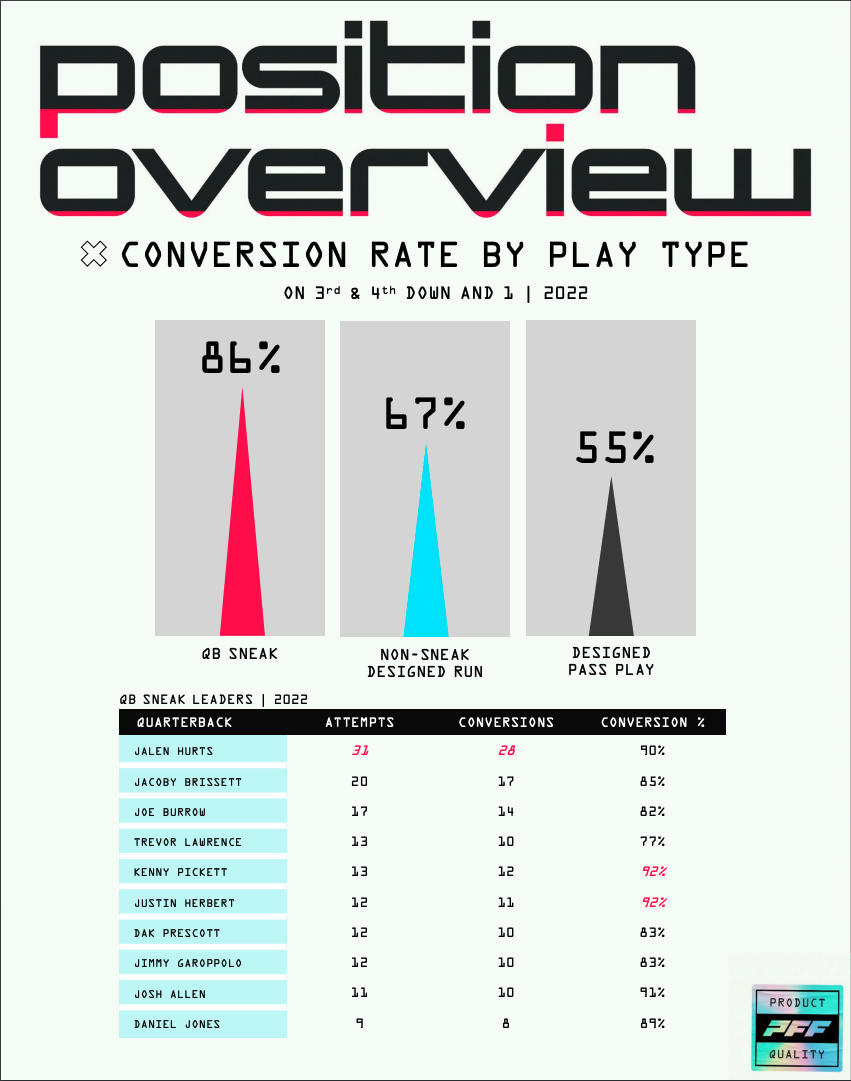
Jalen Hurts and the Philadelphia Eagles led that charge, generating 28 conversions on 31 attempts. And despite some pushback on how Philadelphia converted most of those, there won’t be any rule changes around pushing from behind on sneaks for 2023.
It’s a copycat league. Expect to see north of 300 quarterback sneaks in 2023.
No one got the ball downfield quicker than Tua Tagovailoa
Plotting average time to throw against average depth of target shows a pretty clear positive correlation between the two metrics. Quarterbacks who push the ball further downfield tend to hold on to the ball longer in order to let those downfield routes develop.
Tua Tagovailoa was the exception in his first season under Mike McDaniel in 2022.
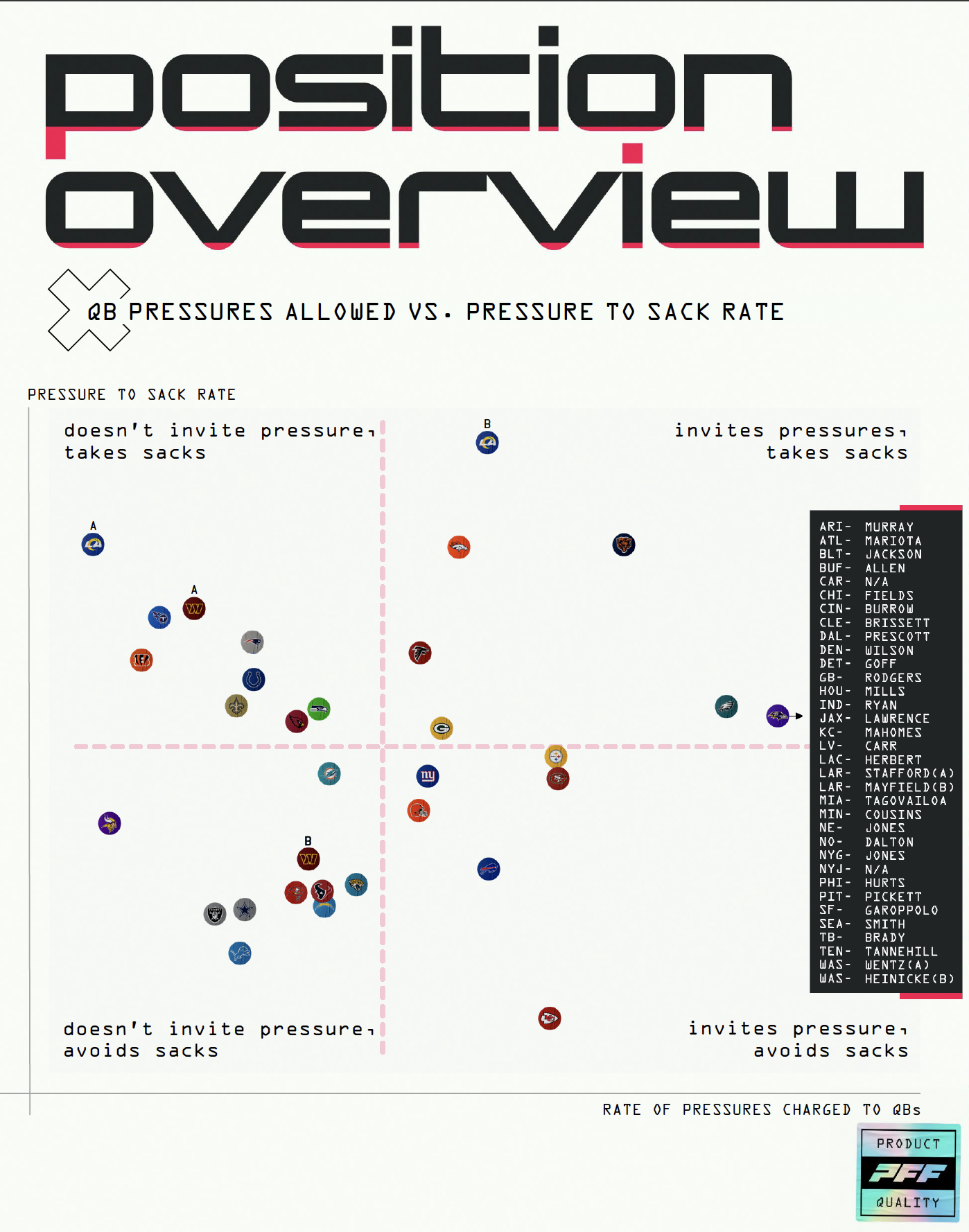
Tagovailoa — along with Marcus Mariota — was one of two quarterbacks who recorded an average depth of target over 10 yards downfield. He put up that number despite a 2.52-second average time to throw, which ranked fourth-lowest in the league.
That’s one way to use the fastest receiving corps in the NFL to mitigate an offensive line that has been questionable over the last few years — get the ball downfield before the pass rush has much time to get home.
Normal rules related to time to throw and pressure don’t apply to Patrick Mahomes
Mahomes is in the opposite quadrant to Tagovailoa in the time to throw vs. average depth of target scatterplot. High time to throw and low depth of target isn’t typically a place a quarterback would want to be because, in theory, that means chipping away at the “reward” that comes with holding on to the ball. But if there’s one thing Mahomes has shown through his five seasons as a starter, it’s that normal rules associated with playing the position don’t apply to him.
The Chiefs superstar earned a 91.0 passing grade on dropbacks that took three or more seconds last season. Josh Allen came in second at just 78.2. No quarterback in the league better understands how to extend plays while mitigating risks, and his placement on the scatterplot below does an excellent job of visualizing it.
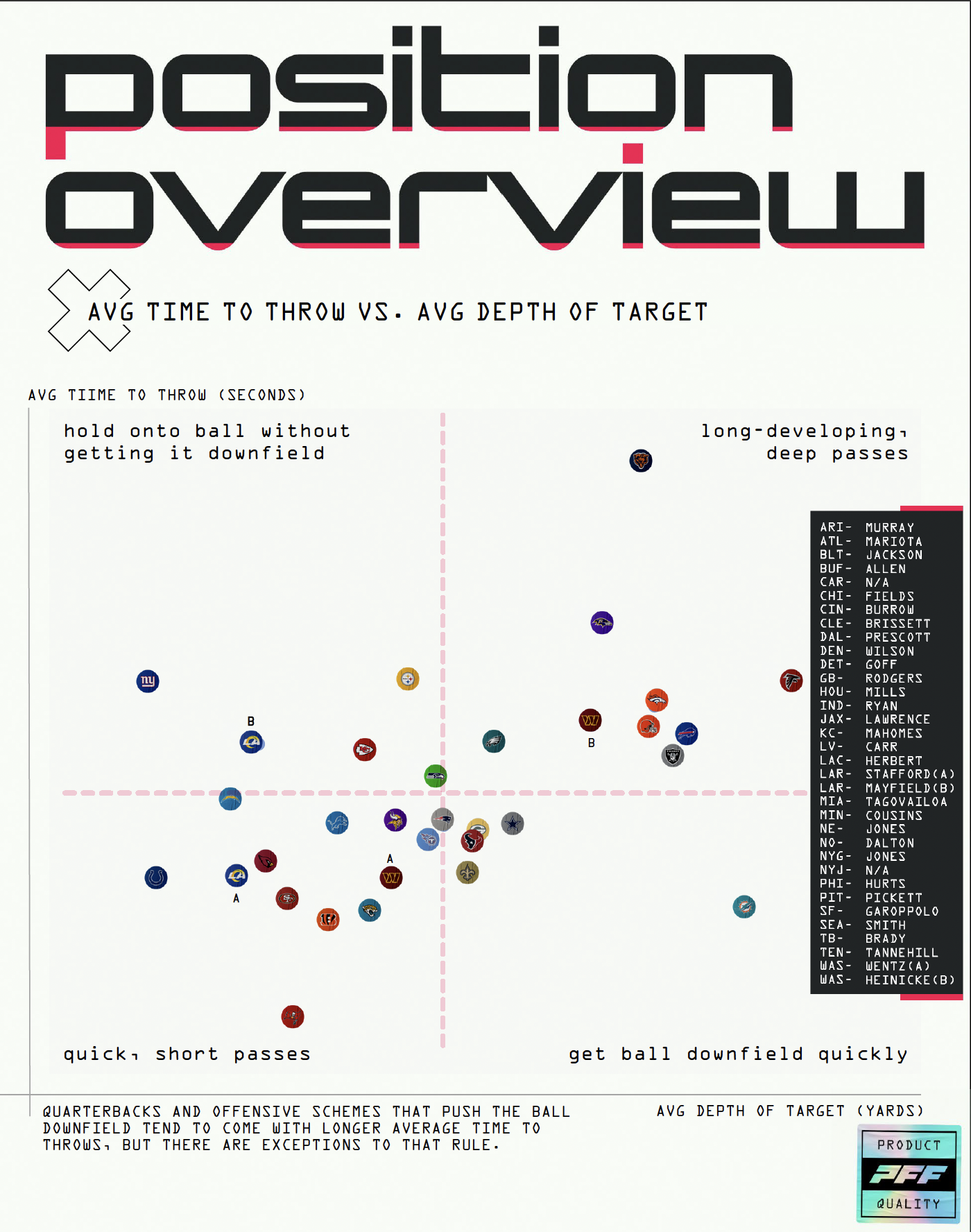
A significant chunk of Mahomes’ pressures were charged to him (placement on the X axis), but he took sacks when pressured at the lowest rate in the NFL (placement on the Y axis). No quarterback is better against pressure, but Mahomes’ ability to control his pressured dropbacks, rather than have those same dropbacks dictate his play, is an underrated part of what makes him the best quarterback in the league.
Joe Burrow is as reliable as it gets across PFF’s stable metrics
Below is a brief overview of stable and unstable metrics:
Stable metrics tend to be more predictive of future success than unstable metrics. The most stable facets of quarterback play are those with the biggest sample sizes, even though they intuitively seem “easier.” Unstable metrics are more volatile when it comes to projecting quarterback play, and results tend to vary from year to year.
It’s not exactly a hot take, but after looking through that lens, we can be fairly confident that Burrow will be elite again in 2023.
We featured six stable metrics in the PFF QB Annual for 2023 — grade from a clean pocket, on standard dropbacks, on early downs, on dropbacks with no play action, on passes thrown at/beyond the sticks and the rate at which the QB avoids negative grades — and the Bengals signal-caller graded above the 97th percentile at the position in all of them.
He’s not the only quarterback in the conversation, but he’s the safest bet for QB2 behind Mahomes heading into next season.
C.J. Stroud will be looking to avoid the massive decline in accuracy Justin Fields suffered from college to pros
Like his predecessor at Ohio State, Stroud was one of the most accurate quarterbacks in college football during his two-year stint as a starter. He’ll now hope to bring that accuracy to the NFL game, something that Fields has struggled to do so far.
Accurate pass rate in college vs. NFL
| Quarterback | Accurate pass % in final college season | Accurate pass % in first two NFL seasons |
| Justin Fields | 72.4% (1st in FBS) | 51.1% (31st in NFL) |
| C.J. Stroud | 68.0% (2nd in FBS) | ? |
Fields led all FBS quarterbacks in accuracy rate over the 2020 college football season, with his accuracy hailed as one of his biggest strengths. But outside of that Ohio State offense, Fields’ accurate pass rate has dropped over 20 percentage points in the NFL. His mark of 51% over the last two seasons beats only Zach Wilson among qualifiers.
It is worth monitoring how Stroud makes the transition, given Fields’ struggles as a passer early in his NFL career after having so much success at Ohio State.
Trevor Lawrence got the ball out in rhythm better in his first season in Doug Pederson’s offense
Lawrence took a clear step forward in his second NFL season, thriving in Doug Pederson's offense over the second half of the year. One of the biggest changes from his rookie campaign was his willingness to get rid of the ball quickly and the offense’s effectiveness when he did so.
Lawrence’s average time to throw was cut by over three-tenths of a second to 2.51 seconds in 2022 (third-lowest in the league), and Jacksonville’s offense was elite when Lawrence got it out quickly. The Jaguars averaged over 0.3 expected points per play (second in NFL) and over 6.0 yards per play when Lawrence got rid of the ball in two seconds or less.
The only quarterback to generate more EPA per play in those situations was Garoppolo in San Francisco, which speaks to Pederson’s ability to generate quick, open throws. It was something Lawrence clearly missed as a rookie and a reason for optimism as that duo goes into its second year, now with Calvin Ridley added into the mix.
Geno Smith is carrying the mantle on deep, over-the-shoulder throws in Seattle
From 2015 (when PFF first began tracking pass types) to 2021, Russell Wilson threw 59 passing touchdowns on over-the-shoulder throws — 15 more than any other QB. No one was better at delivering those accurate, high-arcing deep balls.
Last season, Smith picked right up where Wilson left off. His 14 completions and seven passing touchdowns on the pass type both tied for the league lead and his 96.8 PFF passing grade on over-the-shoulder attempts beat out notable contenders like Joe Burrow, Josh Allen and Jalen Hurts for the highest mark in the NFL.
The addition of Jaxon Smith-Njigba to the receiving corps and a year under the belts of young offensive linemen such as Charles Cross and Abraham Lucas should put Smith in an even better position entering 2023.
Justin Herbert got locked into underneath throws in LA’s offense last season
Former offensive coordinator Joe Lombgototten the majority of the criticism for the Chargers’ conservative passing game in 2022, but the Chargers’ route vs. target heat map from last season points to the idea that some blame falls on Herbert.
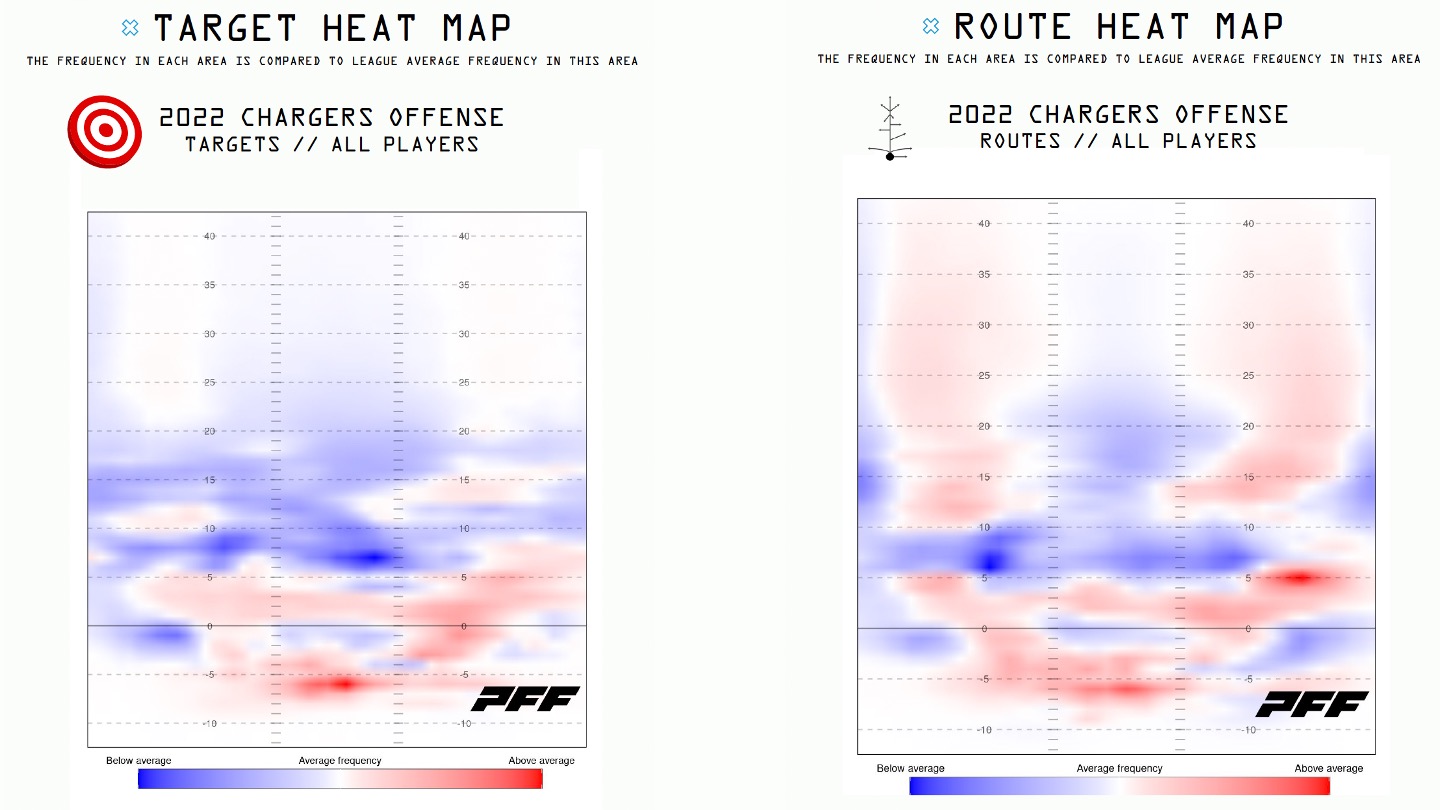
On the route heat map, there are two “hot zones” down the sidelines over 10 yards downfield that aren’t present on Herbert’s target heat map. However, the maps don't capture other critical pieces of context — were most of those deeper routes clear-out routes? Where did they come in Herbert’s progression? How much did injuries along the offensive line and to the receiving corps impact Herbert’s confidence in his ability to push the ball downfield?
Still, there is enough of a discrepancy between where the Chargers ran their routes and where Herbert threw the ball to indicate that Herbert was probably too often locking into underneath throws en route to a 7.0-yard aDOT that ranked third-lowest among qualifiers.
One of the biggest questions for the Chargers in 2023 will be whether Herbert and new offensive coordinator Kellen Moore can work together to bring back some explosiveness to their passing game.
Pittsburgh’s passing offense ignored one of the most valuable areas of the field in 2022
The heat map of Pittsburgh’s routes with Kenny Pickett behind center leaves a void between the numbers, particularly the middle of the field at intermediate depths. That’s not just blue in the middle — it’s as dark a blue as the scale goes.
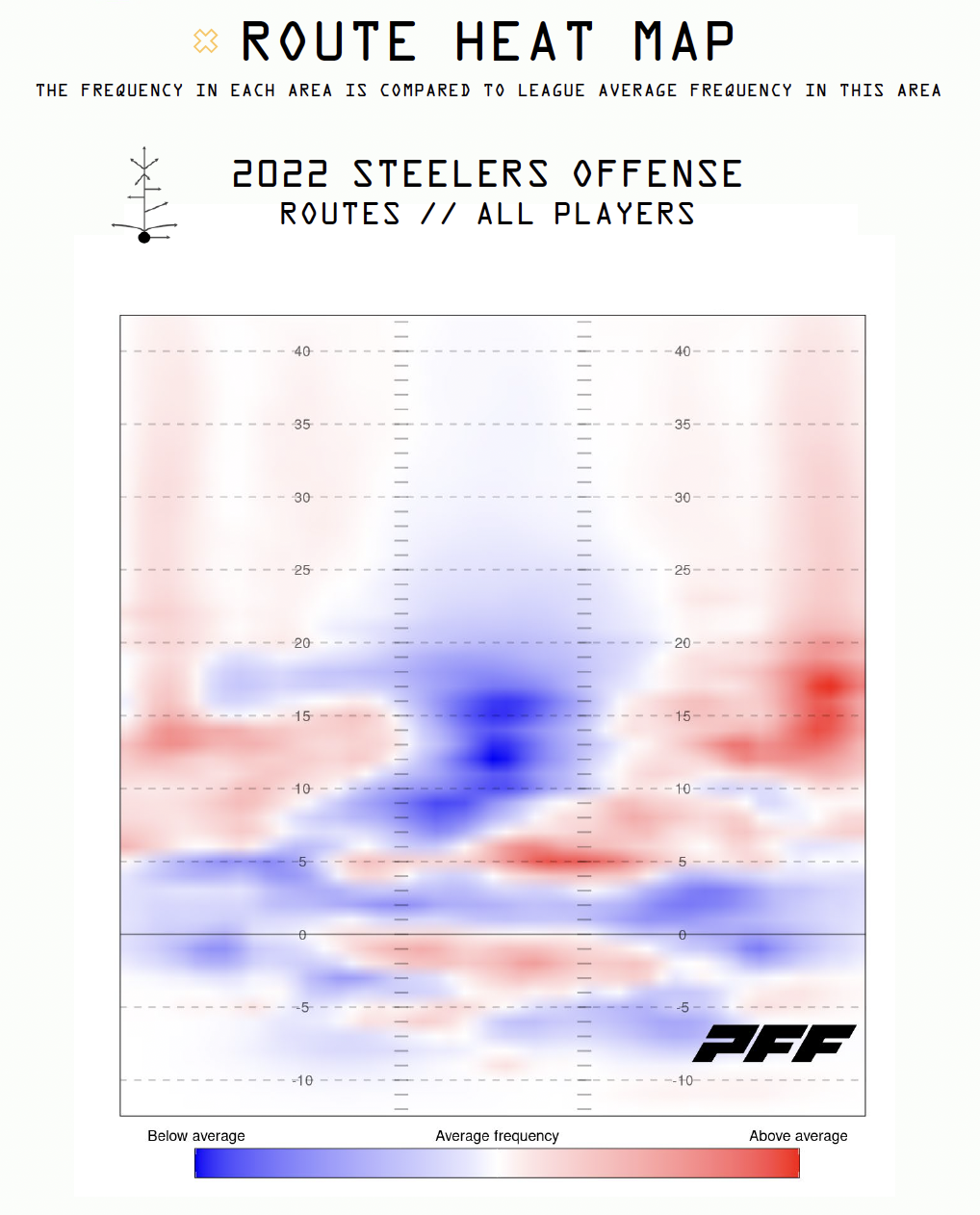
For several years now, the Steelers’ passing offense has been one of the least diverse in the league. It’s a lot of quick-hitting routes outside the numbers, with the deeper opportunities coming almost exclusively on go-balls down the sideline. Receivers like George Pickens can win in those downfield, 50-50 situations, but it’s a tough way to move the ball consistently, especially without a run game to help keep the offense on schedule.
In Matt Canada’s two years as offensive coordinator, the only two teams with fewer passing yards between the numbers on throws at least five yards downfield than the Steelers (1,945) are the Chicago Bears (1,786). The total pass attempts over that two-year stretch are 1,235 for Pittsburgh (sixth-most in NFL) compared to 919 for the Bears (last in NFL).
Pickett and Canada will need to do a better job of attacking the middle of the field in their second season together for the passing offense to make the most of a talented supporting cast.
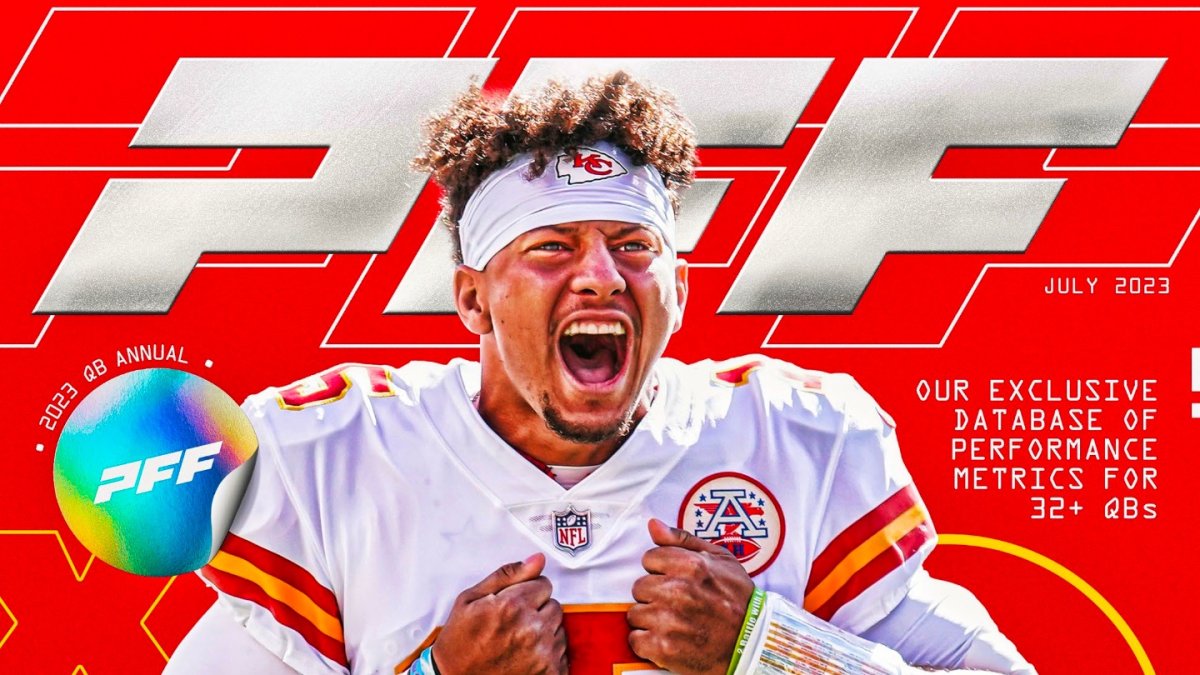


 © 2024 PFF - all rights reserved.
© 2024 PFF - all rights reserved.